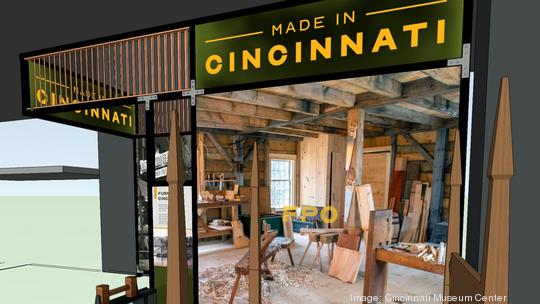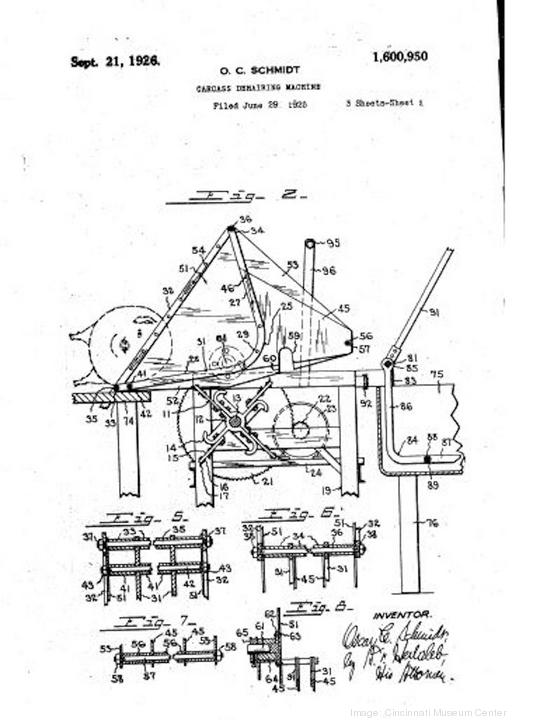
Cincinnati was built on more than just beer and pigs, and the Cincinnati Museum Center is putting all of the city’s innovative and entrepreneurial efforts front and center with its newest permanent exhibit, “Made in Cincinnati.”
The display, which CMC said showcases “products made in Cincinnati, innovations that transformed the market and people who have powered Porkopolis,” officially opens to the public Friday, July 1.
"Made in Cincinnati" is the Museum Center’s first new permanent display since July 2021 and an idea that’s been in the works since 2014. In honor of its debut, here’s a rundown of the 10 coolest inventions with Cincinnati connections, some you may know, others you may not:
1. Weather mapping and forecasting: The country’s first weather maps originated in Cincinnati — predicting the weather rather than merely reporting on it. That’s a credit to Cleveland Abbe, who had taken charge of the Cincinnati Observatory in 1868. Stacey Kutish, senior director of exhibit development for the Cincinnati Museum Center, told me Abbe got a cast of people from across the Midwest to start sending in weather data using a telegraph. As his team started to document it, they could see how patterns spread across the region. The result? Regularly printed forecasts. In 1871, less than a year after the founding of the National Weather Service, Abbe joined the agency, serving as a stabilizing force in the weather service. “It’s a lesser known but cool story,” Kutish said. “We think of citizen science (or scientific crowdsourcing) as a new breakthrough, but in fact, we’ve been relying on it for quite some time.”
2. The hydraulic elevator: Warren Warner, a Cincinnati engineer, claimed to have built the first hydraulic elevator in Cincinnati. In the early 1890s, he invented the first emergency safety catch, to prevent elevator falls and failures. He used to show just how safe the catch was by loading an elevator with a grand piano — along with his wife and daughter — before cutting the supporting cable.
3. Fashion Frocks: Fashion Frocks, a mid-century, Cincinnati-based company, was among the first outfits (no pun intended) to sell direct-to-consumer. The company’s salesforce included mostly married women — Fashion Frocks employed around 50,000 worldwide — who would sell its wares, first door-to-door in the 1940s, then “Tupperware party style" in the 1950s. Buyers could choose an outfit from a fashion card, which included a fabric swap, and the sales rep would take their measurements, jot down their shipping information and send in the order. Fashion Frocks were made in what’s known today as the American Sign Museum in Camp Washington and mailed directly to the consumer’s home. Kutish said Fashion Frocks sewed more than 2 million dresses per year.

4. The Swiffer: Procter & Gamble-related innovations are, of course, too numerous to mention — from Ivory soap to Pampers diapers, the company could have its own top 100 list. The Swiffer, however, stands out as an example of P&G’s dedication to consumer learning, Kutish said. The Cincinnati-based consumer products giant, now a $76.1 billion operation, was one of the earliest companies to do shop-alongs and home visits. The Swiffer was born out a series of anthropologic-like home studies. The floor cleaning process, as the P&G team learned, was arduous: it required moving furniture, sweeping loose dirt, mixing solution, preparing a mop and more. And when complete, it required a “clean up of the clean up.” The Swiffer was officially unveiled in 1999.
5. The Boyd bedstead: Investor, carpenter and mechanic Henry Boyd was born enslaved in Kentucky. He managed to buy his own freedom and eventually that of his siblings, Kutish said. He settled across the Ohio River and eventually opened his own workshop, becoming one of the most successful furniture makers in Cincinnati. Boyd invented the “Boyd bedstead,” a corded bed with a mechanism that would inherently tighten with weight, preventing sagging. As his idea was duplicated, he started to add his signature to each bedstead — a stamp that read “H. Boyd, Cinci OH.” The bedstead on display at the Cincinnati Museum Center is circa 1845. Kutish said it’s a rare collection item. The other premier Henry Boyd bedstead is currently on display at the Smithsonian.
6. The ability to fight fire with steam: In 1853, Cincinnati inventors created the first practical steam fire engines. In quick succession, Cincinnati became the first city in the U.S. to employ a paid, full-time professional fire department. The steam engine model set the standard for fire protection for decades to follow. “There were definitely fire trucks before, but the water was handpumped,” Kutish said. “Employing steam had been tried, but it was completely unsafe and unusual. We made it practical and exported it all over the world.”
7. The launch of the “disassembly” line: In the 1840s, thousands of pigs landed in Cincinnati every day. The "disassembly” line, invented here, helped speed up the meatpacking process, using a trolley system to move pig carcasses from station to station. People took notice. Henry Ford looked at disassembly lines and reversed the process, thus the assembly line.

8. An epicenter of machine tools: Cincinnati has been regarded as the manufacturing machine tool capital of the world, particularly in the 1930s. It was the place for lathes, milling machines, drills and more.
9. Rookwood Pottery: The story of Rookwood Pottery is perhaps more well-known than most — the company is credited for launching the art pottery movement in America. Rookwood was founded on Thanksgiving Day in 1880, the first large manufacturing enterprise founded and owned by a woman (Maria Longworth Storer) in the U.S. Rookwood pieces are still handmade by using its proprietary glazes.
10. The Filet-O-Fish: This may be a stretch, but it's certainly a delicious departure from patents and high-tech machinery. Fish sandwiches certainly existed prior to the Filet-O-Fish, but its creation was a credit to a very Catholic community in Cincinnati and Lou Groen, a McDonald’s franchisee having trouble making sales on Fridays. Groen targeted Frisch’s as his model, and pitched the idea for his version of the sandwich to the parent company in 1961. Now the Filet-O-Fish is found on McDonald’s menus all around the world.








